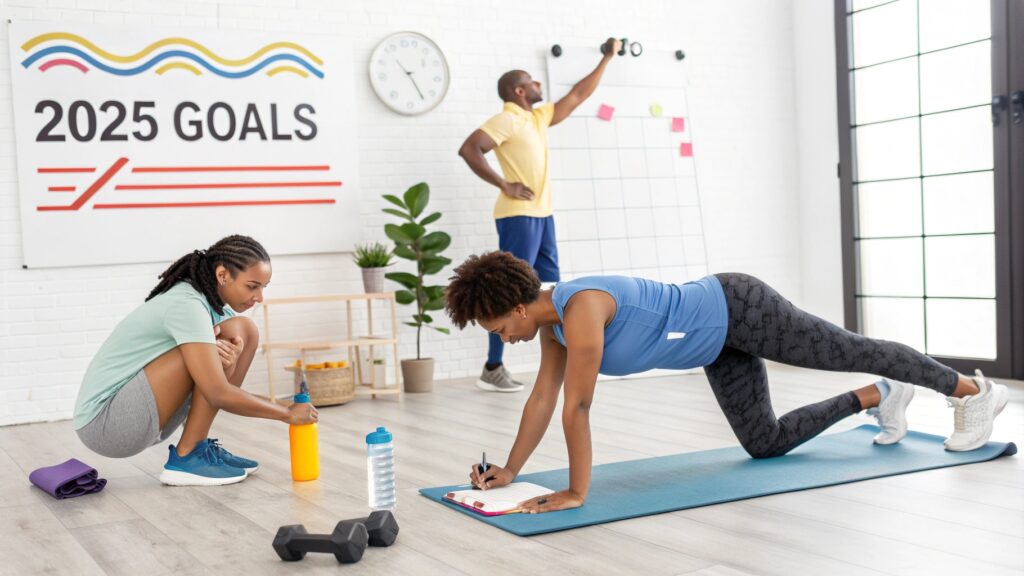Introduction
Welcome to the ultimate 2025 guide for turning “New Year, New You” into reality. Whether you’re a complete beginner or returning after a break, this roadmap blends science‑backed strategies, practical tips, and motivational tactics to help you launch a sustainable fitness journey that delivers real results. Ready to break free from old habits and embrace a healthier, stronger you? Let’s get started.
Set Clear, Achievable Goals (Great Keyword)
Why Goal‑Setting Matters
Goals give your fitness efforts direction and purpose. Without a clear target, workouts can feel aimless, and motivation quickly fades. Research shows that specific, measurable, attainable, relevant, and time‑bound (SMART) goals increase adherence by up to 40 % compared with vague intentions like “Get fit.” By defining exactly what you want to achieve—whether it’s shedding 15 pounds, running a 5K, or building lean muscle—you create a roadmap that your brain can follow.
Creating Your SMART Fitness Goals
Start with a broad vision (e.g., “I want to be healthier”) and break it down:
-
- Specific: “I will lose 12 pounds.”
-
- Measurable: Track weight, body‑fat percentage, or performance metrics.
-
- Attainable: Set a realistic timeline—12 weeks for 12 pounds is safe.
-
- Relevant: Align with your personal motivations (e.g., more energy for family).
-
- Time‑Bound: “By July 31, 2025.”
Write these goals down, keep them visible, and revisit them weekly to assess progress and make adjustments.
Building Mini‑Milestones
Large goals can feel overwhelming, so carve them into bite‑sized milestones. For example, aim to lose 1–2 pounds per week, increase treadmill time by five minutes every two weeks, or add two extra reps to each strength set. Celebrating these small wins fuels momentum and keeps the larger objective within reach.
Design a Balanced Workout Program (Great Keyword)

Understanding the Three Core Fitness Pillars
Effective fitness isn’t just cardio or lifting; it’s a blend of:
-
- Cardiovascular training – improves heart health, burns calories, and boosts endurance.
-
- Strength training – builds muscle, raises resting metabolic rate, and protects joints.
-
- Flexibility & mobility work – enhances range of motion, reduces injury risk, and aids recovery.
Integrating all three ensures a well‑rounded physique and minimizes plateaus.
Choosing the Right Frequency
For most beginners, 3–5 sessions per week strike the perfect balance between stimulus and recovery. A sample weekly layout could be:
-
- Monday – Full‑body strength (45 min)
-
- Tuesday – Low‑impact cardio (30 min) + mobility (15 min)
-
- Wednesday – Rest or active recovery (light walk, yoga)
-
- Thursday – Upper‑body strength (40 min) + HIIT (15 min)
-
- Friday – Lower‑body strength (45 min)
-
- Saturday – Outdoor cardio (45 min) + stretching (15 min)
-
- Sunday – Rest
This schedule provides adequate stimulus while allowing muscles to rebuild and grow.
Progressive Overload Made Simple
The secret to continual improvement is progressive overload—gradually increasing the demands placed on your body. Ways to apply this principle include:
-
- Adding 5 lb to a lift each week.
-
- Increasing interval duration in a HIIT session by 10 seconds.
-
- Adding a set or two to an exercise.
-
- Improving form and depth (e.g., deeper squat).
Track these adjustments in a workout journal or app; seeing the numbers climb is a powerful motivator.
Master Nutrition Fundamentals (Great Keyword)

Calories In vs. Calories Out
Weight loss or gain ultimately hinges on the caloric balance. Use an online calculator (or consult a registered dietitian) to estimate your Total Daily Energy Expenditure (TDEE) and subtract 250–500 kcal for steady fat loss. Conversely, to build muscle, add 250–300 kcal to fuel growth while maintaining a protein‑rich diet.
Macronutrient Ratios for 2025
While individual needs vary, a solid starting point for most adults is:
-
- Protein: 1.0–1.2 g per lb of body weight (e.g., 150 g for a 150‑lb person). Supports muscle repair and satiety.
-
- Fats: 20–30 % of total calories. Prioritize omega‑3 rich sources (salmon, flaxseed, walnuts) for inflammation control.
-
- Carbohydrates: Fill the remaining calories, focusing on complex carbs (sweet potatoes, quinoa, oats) for sustained energy.
Adjust ratios based on personal preferences, activity level, and how your body responds.
Meal Timing, Hydration, and Supplements
Eating protein within 30–60 minutes post‑workout maximizes muscle protein synthesis. Aim for 20‑30 g of high‑quality protein in that window. Stay hydrated—goal of at least 3 L water daily, more if you sweat heavily.
Supplements are optional but can help fill gaps:
-
- Whey or plant‑based protein powder for convenient post‑workout nutrition.
-
- Creatine monohydrate (5 g daily) to boost strength and power.
-
- Vitamin D3 if you lack sunlight exposure.
-
- Fish oil for joint health.
Always consult a healthcare professional before adding new supplements.
Build Sustainable Habits (Great Keyword)
The Power of Micro‑Habits
Instead of overhauling your entire lifestyle overnight, focus on tiny, repeatable actions. Examples include:
-
- Doing 5 minutes of stretch — every morning.
-
- Preparing a fruit‑based snack the night before.
-
- Walking for 10 minutes after dinner.
Science shows that micro‑habits are 2–3 times more likely to stick because they require minimal willpower.
Environment Design for Success
Make the healthy choice the easy choice. Keep workout clothes visible, place a water bottle on your desk, and stock the fridge with lean proteins and veggies. Remove temptations—store junk food out of sight or replace it with healthier alternatives.
Tracking, Accountability, and Adjustment
Use a simple tracking system—whether a printable habit‑tracker, an app like MyFitnessPal, or a bullet journal. Record workouts, meals, sleep, and mood. Review weekly: celebrate consistency, identify gaps, and tweak your plan. Pairing yourself with an accountability buddy or joining a virtual community dramatically improves adherence.
Stay Motivated All Year Long (Great Keyword)
Intrinsic vs. Extrinsic Motivation
Intrinsic motivation (feeling good, improved self‑confidence) outlasts extrinsic motivators (badges, trophies). While external rewards can jump‑start a habit, focus on how each workout makes you feel—stronger, calmer, more energized.
Visualization and Goal Refocusing
Spend 2–3 minutes each morning visualizing your future self thriving in the lifestyle you’re building. Write a “future‑self” letter describing achievements you’ll celebrate in six months. Revisiting this letter during low‑energy days reignites purpose.
Celebrating Milestones without Sabotage
Plan non‑food rewards for reaching targets: a new workout outfit, a massage, or a weekend hike. Avoid using high‑calorie treats as celebration—they can undermine progress and create a negative association with food.
Overcome Common Roadblocks (Great Keyword)
Time Constraints
Busy schedules are a frequent excuse. Counter it with “micro‑workouts”: 10‑minute bodyweight circuits, high‑intensity interval training (HIIT) sessions, or brisk stair climbs during breaks. Consistency beats duration—five 10‑minute sessions weekly can be more effective than one 50‑minute session you skip.
Plateaus and Stagnation
When progress stalls, change the stimulus:
-
- Swap exercises (e.g., dumbbell bench press → barbell press).
-
- Alter rep schemes (5×5 strength to 3×12 hypertrophy).
-
- Integrate new modalities—kettlebells, battle ropes, or yoga.
Periodized training—alternating weeks of high volume with weeks of heavy load—keeps your body adapting.
Injuries and Recovery
Listen to your body. Persistent pain warrants professional evaluation. Incorporate active recovery: foam rolling, mobility drills, and low‑intensity cardio. Adequate sleep (7–9 hours) and proper nutrition are non‑negotiable for tissue repair.
Mindset Shifts for Long‑Term Success
Adopt a growth mindset: view setbacks as learning opportunities rather than failures. Replace “I can’t do this” with “I’m learning how to improve.” This mental reframing reduces stress and promotes resilience, two critical factors for sustainable fitness.
Putting It All Together:Your 12-Month Action Plan
(Great Keyword)

Month‑by‑Month Blueprint
January – Goal‑Setting & Baseline Assessment: Record weight, measurements, cardio fitness (e.g., 1‑mile run time), and strength (e.g., max push‑ups). Set SMART goals and create a habit‑tracker.
February – Establish Routine: Commit to 3–4 workouts/week, practice meal‑prep on Sundays, and log nutrition.
March – Introduce Progressive Overload: Increase load or volume by 5 % each week. Add a new mobility session.
April – Fine‑Tune Nutrition: Refine macro ratios based on energy levels; experiment with timing.
May – Mid‑Year Review: Compare data to goals, celebrate milestones, adjust TDEE if needed, and set a new mini‑goal for summer.
June – Diversify Training: Try a new sport (cycling, swimming) or a fitness class (pilates, boxing) to prevent boredom.
July – Focus on Strength: Shift to a 4‑day split emphasizing compound lifts (squat, deadlift, bench).
August – Recovery Emphasis: Incorporate a deload week, increased stretching, and perhaps a weekend retreat.
September – Re‑Assess Metrics: Update weight, body‑fat, and performance stats. Adjust calorie targets for continued progress.
October – Mindset & Motivation: Add journaling, visualization, and community challenges (e.g., virtual 30‑day squat challenge).
November – Nutrition Mastery: Experiment with nutrient‑dense recipes; plan for holiday balance.
December – Celebration & Planning: Reflect on accomplishments, reward with non‑food treats, and draft goals for 2026.
Tools & Resources
Consider leveraging these free or low‑cost tools:
-
- MyFitnessPal – calorie and macro tracking.
-
- StrongApp – workout logging and progressive overload charts.
-
- Headspace or Insight Timer – guided meditation for mental resilience.
-
- Fitbod – AI‑generated strength programs based on equipment.
-
- Google Calendar – schedule workouts as non‑negotiable appointments.
Final Thought
The “New Year, New You” mantra isn’t about a dramatic overnight transformation; it’s about cultivating a lifestyle that consistently brings you closer to your ideal health and fitness vision. By setting crystal‑clear goals, designing a balanced training program, mastering nutrition fundamentals, building micro‑habits, and staying motivated through mindset work, you’ll not only achieve your 2025 objectives but also lay the groundwork for lifelong wellness. Remember: progress is a series of small, intentional steps—take them today, and watch the new you unfold.



